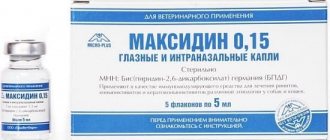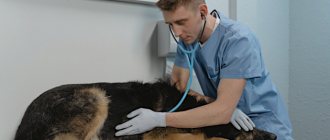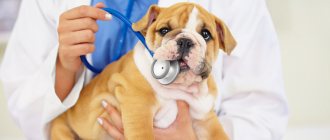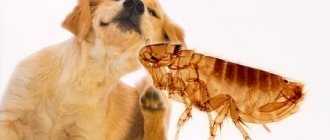The health of people and their four-legged friends depends not only on lifestyle, but also on proper nutrition. The substances entering the body serve as fuel for most of the internal systems, organs and cells. With a lack of a number of important elements, immune strength is reduced, increasing vulnerability to infections and other dangerous diseases.
It is possible to prevent a decline in immunity only with the help of competent prevention, as well as timely contact with a veterinarian at the first signs of vitamin deficiency in a dog.
What is vitamin deficiency in dogs – and why does it appear?
Vitamin deficiency is a pathology caused by a prolonged lack of one or more vitamins. It is often confused with hypovitaminosis, a less dangerous painful condition in which nutrients are still supplied to the body, but in insufficient quantities. Because of this, their expenditure becomes greater than their income.
REFERENCE!
Vitamins are organic compounds necessary for the normal functioning of internal organs and systems. They enter the body along with food or are synthesized in it independently.
All known vitamins are divided into 2 large groups:
- fat-soluble, which are absorbed along with fatty oils and are very slowly eliminated from the body;
- water-soluble, presented in the form of dry substances that dissolve well in water.
The reasons for the lack, or deficiency, of these substances are very diverse. These include:
- poor nutrition (little variety of foods or low quality dry food);
- gastrointestinal pathologies that impair absorption (intestinal inflammation, dysbacteriosis);
- infections (parvovirus enteritis, canine distemper, leptospirosis);
- liver diseases;
- poisoning (isoniazid, rat poison);
- tumors in the gastrointestinal tract;
- infection with worms or protozoa.
Vitamin deficiencies are seasonal. Most often they are diagnosed from late winter to early spring. This is due to an acute lack of sun, which is responsible for the production of vitamin D.
In addition to the time of year, the physiological state of the animal, as well as the conditions of its detention, play a big role. The risk group includes older dogs, puppies, pregnant and lactating bitches, as well as dogs living in dark and damp rooms or receiving increased physical activity (preparing for sports competitions).
Which animals are at risk?
Veterinarians know many reasons why a dog may lack vitamins. These are physiological characteristics, health and nutrition problems. But in some situations, pets are especially vulnerable to vitamin deficiency and other pathologies. The following categories of animals are at risk:
- older dogs;
- pets nursing or bearing puppies;
- juveniles;
- animals after illness or surgery;
- street dogs.
Pets that are under increased stress or preparing for exhibitions and competitions also need an additional source of nutrients.
Symptoms depending on the type of vitamin deficiency
The pathology is notable for its very diverse symptoms. It is difficult to distinguish it from other diseases, so the only reliable way to diagnose it is to take tests. Below you can find out how vitamin deficiency manifests itself in dogs and see photos with the main external signs.
Ah, or retinol
Contained in fatty foods and plays a significant role in the growth and development of the fetus. In addition, it is responsible for immunity and eye health, and also affects protein synthesis.
A lack of retinol is accompanied by the following symptoms:
- lethargy and loss of appetite;
- mucous or bloody diarrhea;
- the appearance of dandruff and bald spots on the coat;
- slow growth in puppies;
- weakness of the paws;
- loss of smell;
- visual impairment;
- late change of primary teeth.
To eliminate deficiency, fish oil is mainly used, which normalizes the absorption of nutrients. Beef liver, egg yolks and butter are also added to the diet.
B2, or riboflavin
Refers to water-soluble. Participates in the formation of antibodies and red blood cells, regulates cell growth and regeneration, and also maintains the health of claws, skin and fur.
REFERENCE!
Riboflavin is closely related to ascorbic acid. If there is little of it, then the level of the latter also decreases.
Insufficient riboflavin causes the following symptoms:
- loss of appetite and severe exhaustion;
- heavy shedding;
- corneal clouding;
- growth retardation in puppies;
- the appearance of ulcers in the mouth.
If treatment is delayed, this type of pathology can be complicated by paresis or paralysis.
B5, or pantothenic acid
Takes an active part in the metabolism of proteins, fats and carbohydrates, forms protective antibodies and stimulates the production of adrenal hormones. If there is an acute deficiency of pantothenic acid, the animal develops the following symptoms:
- loss of appetite and excessive salivation;
- hair loss and change in color;
- darkening of the tongue.
If there is not enough pantothenic acid specifically in the stomach, this can lead to peptic ulcers.
B6, or pyridoxine
In addition to pyridoxine, B6 is found in the form of pyridoxal and pyridoxamine, but the latter 2 elements are less significant. Pyridoxine is responsible for the functionality of joints, heart and nervous system.
REFERENCE!
B6 works in tandem with B12. Together they regulate the absorption of protein food, which is a very important point for all carnivorous animals.
The main symptoms of B6 deficiency include anemia, seizures and dermatitis. Unlike most elements, pyridoxine is completely eliminated from the body after 8 hours. For this reason, its quantity must be constantly replenished.
B12, or cobalamin
Prevents the destruction of red blood cells and fatty degeneration of internal organs, and also helps strengthen the sheath of nerve fibers. The initial stage of deficiency is characterized by severe exhaustion, and the late stage by severe anemia.
C, or ascorbic acid
Refers to water-soluble. Necessary for the growth and repair of bone tissue, teeth, gums and blood vessels. Improves iron absorption and stimulates the activity of immune cells.
A lack of ascorbic acid is accompanied by exhaustion of the body, redness of the oral mucosa, blood in the urine and feces, bleeding gums and tooth loss. The main impact falls on the liver and gastrointestinal tract.
Group D
It is classified as fat-soluble and is responsible for the correct formation of the musculoskeletal system. The main symptoms of group D deficiency include perverted appetite (eating soil, wallpaper and other inedible objects), diarrhea and constipation, cramps, curvature and softening of bones (rickets).
Group E
Affects the functioning of the reproductive system and helps prolong youth. A lack of these elements can lead to infertility and premature aging.
Group K
Regulates blood clotting and healthy liver function, and also protects against the development of osteoporosis. Type K deficiency can be recognized by blood clots in the urine and feces, poor blood clotting, and frequent bleeding. In this condition, even a small wound poses a danger to the animal.
Treatment
How to treat vitamin deficiency in dogs? In fact, the specificity of therapy is the same - to compensate for the deficiency of microelements.
- Vitamin A. For treatment, foods and supplements enriched with this substance are introduced into the diet.
- Vitamin B12 deficiency is treated by subcutaneous injection of a special solution.
- Vitamin C. Veterinarians advise introducing cabbage and special vitamin complexes into the diet. It should be noted that heat treatment of food significantly reduces the content of this substance in it.
- Vitamin D. For treatment, an oil solution containing this trace element is prescribed.
- You can increase the amount of vitamin E by introducing various types of cereals into your diet, including oatmeal and buckwheat.
- AT 2. If, after introducing fish and meat products, as well as eggs, the animal’s condition does not improve, vitamin B2 in its pure form is prescribed.
- B6 is contained in high-quality food; in addition, preparations that include pyridoxine are used.
In any case, if signs of vitamin deficiency occur in dogs on the skin, coat, etc. you should contact your veterinarian.
The danger of self-medication
It is not difficult to guess that eliminating the disease is based on including in the diet foods enriched with missing elements, or taking vitamin and mineral complexes. Despite this, the animal cannot be treated independently. At best, you will achieve nothing and simply waste time, and at worst, you will cause hypervitaminosis.
Inefficiency
Self-selection of vitamins or an ill-considered change in the existing diet may not bring the desired results if you do not guess the deficient element. Instead of normalizing the condition, the disease will progress and give more and more new complications.
IMPORTANT!
The period of death from vitamin deficiency in the absence of proper treatment depends on neglect. In the worst case, animals die in just a month, and in the best - after about 2 years.
Hypervitaminosis
The reverse side of self-medication is hypervitaminosis, that is, a pathological condition completely opposite to vitamin deficiency. Most often, it develops with uncontrolled intake of vitamin complexes, where the active substances include several types of vitamins.
Such drugs can only be given as prescribed by a veterinarian and strictly in individual dosages. Otherwise, successful replenishment of one substance can lead to a parallel surplus of another.
Hypervitaminosis undermines the health of the animal as a result of poisoning. Substances that are unnecessary for the body begin to be deposited in the kidneys, liver and other organs, worsening their functionality.
Prevention
To avoid diseases associated with vitamin deficiency and not to observe how vitamin deficiency develops in dogs, it is necessary to take care in advance of a balanced and nutritious diet for your pet. If an animal eats commercial feed, you should choose only a high-quality product that matches the characteristics of the breed and age.
When feeding natural food, you should buy your dog vitamin supplements and complexes and create a menu only from healthy foods.
As is the case with other pathologies, it is easier to prevent vitamin deficiency than to later correct the damage caused to the pet’s body.
How to properly treat vitamin deficiency in a dog
In addition to changing the diet and taking vitamin supplements, for your pet’s recovery it is important to find and eliminate the cause of vitamin deficiency. To do this, you need to pass a series of laboratory tests and undergo some instrumental studies.
Get tested
To confirm deficiencies and identify specific types of missing elements, an advanced blood test for the most vital vitamins is used. Before delivery, the animal is kept on a 12-hour fasting diet.
Other tests are done on an individual basis based on existing symptoms. If the veterinarian suspects the presence of concomitant gastrointestinal pathologies, infections, liver diseases, tumors or parasites, then the list is supplemented by clinical examination and blood biochemistry, fecal analysis for helminths, ultrasound and x-rays.
Get veterinarian recommendations
After receiving the results of all the studies performed, an effective treatment is selected for the four-legged patient. If the cause lies in concomitant pathologies, then after their elimination the condition normalizes by itself. In other cases, the problem is solved by proper nutrition, taking vitamins in the form of tablets or intramuscular solutions.











